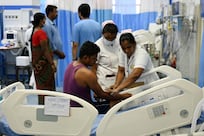The corrugated iron and plastic tarpaulins of the sprawling slum of Dharavi in Mumbai stand in sharp contrast to the gleaming steel and glass buildings of the new business district, located on the other side of a stagnant creek.
Situated on prime land in the overpopulated Indian city, plans have long been in the works to redevelop the slum, one of the largest in the world - and made famous after being featured in the Oscar-winning film Slumdog Millionaire.
Dharavi is not just home to an estimated 1 million people, but a multitude of industries and small businesses, from weavers to potters, with its economic output pegged at more than US$1 billion (Dh3.67bn) a year, according to some estimates.
Many of the slum's business owners and workers are concerned that the long-delayed government redevelopment plan will hurt their livelihoods. "The redevelopment will benefit not the people of Dharavi, but the builders and the developers," says Dhanshukh Shiva Parmar, the president of the local potters' association.
There are about 1,200 families and 12,000 workers in the potters' colony of the slum, he explains. Behind the shop fronts, with their wares neatly displayed, there is a labyrinth of alleyways and spaces, with clay candleholders being baked in kilns and potters working at their wheels in their cramped, dark homes moulding hundreds of pots, some of which are exported to Europe and Asia.
"They will lose their traditional way of working," says Mr Parmar, adding that many of the businesses have been in the families for several generations and that they own the land.
"Most of them will go out of business. They can't afford to start another business in a city like Mumbai," he says.
Mr Parmar explains that multistorey buildings, which are likely to replace their dwellings, are not suitable for their industry, which depends on areas where they can get exposure to the sun to dry their products and open areas for their fire-powered kilns.
"We're not against redevelopment," he adds. "We want better hygiene, good roads, and better living facilities, but we want to do the development ourselves." Mr Parmar was among thousands of residents who protested against the start of rehabilitation work on one sector of the slum at the beginning of this month and managed to prevent it from going ahead.
Although the Dharavi redevelopment programme was first announced eight years ago, work has yet to start. In 2007, the project attracted interest from the Dubai developer Limitless and Emaar's joint venture in India, Emaar MGF, but the Indian government's plans to issue any tenders faced repeated hurdles.
In a small room, down a narrow alley in Dharavi, Mohammed Khalid Sheikh, makes designer-quality leather bags. He earns about 15,000 rupees (Dh1,007) a month.
"I want to stay here and work in this place, but I don't know if I'll be able to," he says.
Meanwhile, Shaikh Abu Khalid, runs a thriving plastic recycling factory in the slum. He says that his business will certainly be scrapped as part of the redevelopment project because it is considered "a pollutant".
"We're not sure when it will happen," he says. "Eight years have passed since the declaration of the redevelopment."
There are some, however, who are fully supportive of the plan.
"People are in two minds," says Nathalal Chauhan, who runs a pottery business, which has been in his family for more than 100 years, since his ancestors moved from Gujarat to an area that was then considered to be outside what was known as Bombay at that time.
Following the redevelopment, "the business could be 10 times more", says Mr Chauhan.
By developing factories in multistorey buildings and developing a range of ceramics, he argues that they will be able to sell their products at far higher prices, as he points out that they are selling their hand-painted clay candleholders for 5 rupees each.
Mahendra Shinde, a former municipal leader and a politician for the Congress party in the area, says that the project will provide good schools and hospitals, which are much needed by the area. He says that despite the protests this month, the work on one part of the slum will begin soon, and once that gets under way, tenders would be issued for the other sectors.
"We have different schemes for different businesses," says Mr Shinde. "Different colonies will have all the facilities they want."
Joachim Arputham, the president of the National Slum Dwellers Federation, who is based in Dharavi, agrees that redevelopment of the area is much needed, but, he argues that residents and businesses need to be fully involved in the plans for the rehabilitation of the area.
"Dharavi needs to be redeveloped," he says. "There are two parts to the redevelopment. One part is what is going to the builders, the developers, who will make a commercial benefit out of it. The remaining part is the redevelopment of the slum.
"There is not a proper community consultation. The community, which is the legal owner of this land as per the government law, has to be consulted."





